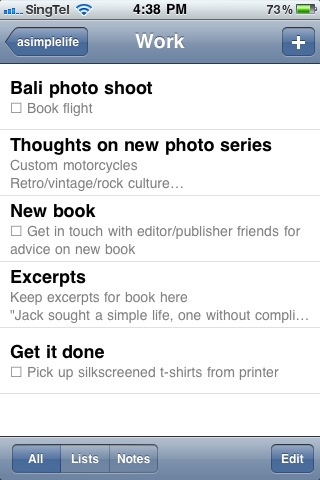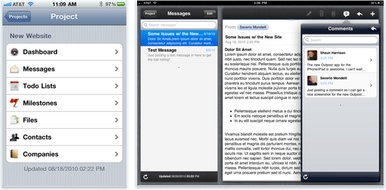We chose to roll the 37signals Suite out in stages. Right now you can actually only upgrade to the suite. You need to have one of the existing products and then you go to your account screen and you click upgrade. That was a way for us to cut down a little bit of the complexity in this. This was already a long running project, [so the question was]: How can we get it out now rather than just spend another three months on it?

About Basecamp
Basecamp is everyone’s favorite project management app.
Meet the team, if you'd like.
The number one competitor we have in our business is not Microsoft, Google, or some other startup somewhere. The number one competitor we have is simple things, like email…
People are organizing through email. They’re keeping track of their notes through email. They’re doing all this stuff through email. And email is incredibly simple, basically just a text box that you can send to other people or receive.
We have to be just one step above that. Most software developers in our space think they need to be far, far beyond that. The more complex they can be, the more features they list on the back of the box, the better it’s going to be — without realizing that’s not how most people operate. Most people operate just with email. So if we can just be one step above that, then we’re doing pretty well.
Audio of DHH speaking to A Better Way Of Work on the theme of simplicity
Product Blog features Extras: Backpocket, Mountain Desk, Spootnik, The Bee, Save Your Call, and Summit
Some recent posts at the 37signals Product Blog:
Extras
Access your Backpack account on your iPhone with Backpocket.
Mountain Desk is a desktop application for Basecamp.
You can now work just like you would normally using Basecamp while all your changes automatically stay in sync. Furthermore unlike regular Basecamp, you can continue to work even when there is no internet connectivity. So if you are on the road, travelling by air or on a client site, the application continues to function normally and allows you to make changes and additions to your project data. As soon as mountain desk detects internet connectivity all your changes are automatically synced.”
Macworld looks at how Spootnik bridges Basecamp and OmniFocus.
Spootnik can sync Basecamp with just, say, an iPhone or iPad (no Mac version is needed as an intermediary), or with every type of Apple-made device you can throw at it. It also provides a separate Web interface for editing your OmniFocus tasks in a browser.
The Bee, online invoicing app, imports time entries from Basecamp projects.
Sure, you can pull time entries from your instance of Basecamp to create invoices in the Bee. You can also pull time entries from projects found in your client’s Basecamp instance. This is really helpful, if you are collaborating on projects as a freelancer or subcontrator.
Continued…
The things you do more often are the things you’re going to get good at. So if you get really good at spending money, you’re going to be really good at spending money. If you have to work on making money from day one, you’re going to get really damn good at making money. And that’s what you need to be as an entrepreneur…
The problem I have is when companies’ business model is free only. And then they say, “We’ll figure out how to make money later.” As if there’s going to be this magic switch they can flip…If you’re not practicing making money, you’re not going to be able to flip that switch and just know how to do it really well. You need to have some time. You need to have some experience at making money.
New jobs on the Job Board and web design firms on Sortfolio
View all of the jobs and internships at the 37signals Job Board.
Programming Jobs
Cycling Sports Group is looking for a Software Engineer in Bethel, CT.
Evri is looking for an UI Engineer in Seattle, WA.
Berklee College of Music Online School is looking for a Musically-Inspired RoR Web Developer in Boston, MA.
Crowdcast is looking for a Ruby on Rails Engineer in San Francisco, CA.
View all Programming Job listings.
Design Jobs
W. W. Norton & Co. is looking for an Interaction Designer in New York, NY.
Vann’s is looking for a Web Designer in Missoula, MT.
Amazon is looking for a Senior UX Designer, Community & Social Shopping in Seattle, WA.
Mashable is looking for a UI Designer in SF, NYC or virtual.
The Job Board also has iPhone Developer Jobs, Customer Service/Support Jobs, Business/Exec Jobs, and more.
Sortfolio Web Designers
Upstatement is headquartered in Boston and has a typical project budget of $25,000-$50,000.
Mural is headquartered in Dallas and has a typical project budget of $10,000-$25,000.
FusionLab, Inc. is headquartered in New York and has a typical project budget of $10,000-$25,000.
SemiBig is headquartered in San Francisco and has a typical project budget of $10,000-$25,000.
Experimenting with responsive design in Iterations
Iterations was a good place for us to implement some responsive design ideas we’d been interested in trying.
As it turned out, making the layout work on a variety of devices was just a matter of adding a few CSS media queries to the finished product. The key to making it easy was that the layout was already liquid, so optimizing it for small screens meant collapsing a few margins to maximize space and tweaking the sidebar layout in the cases where the screen is too narrow to show two columns.
The CSS max-width property seems almost forgotten in the web designer’s toolbox since it wasn’t supported by Internet Explorer 6. With that restriction lifted, it’s the perfect compliment to a liquid layout letting the content re-flow naturally at a variety of widths but not expanding to the point of absurdity where extreme line lengths make reading a chore. It’s a great compromise between liquid and fixed layouts.
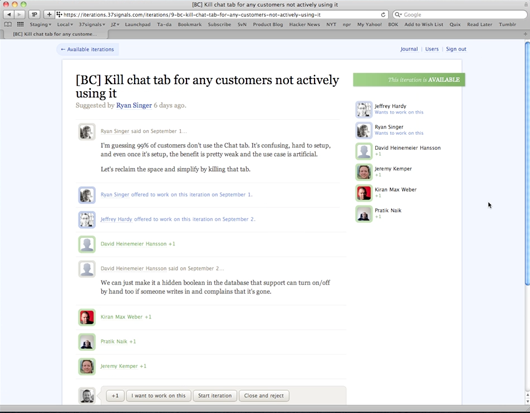 A wide view. The max-width property keeps the width of the content at a reasonable size for nice reading.
A wide view. The max-width property keeps the width of the content at a reasonable size for nice reading.
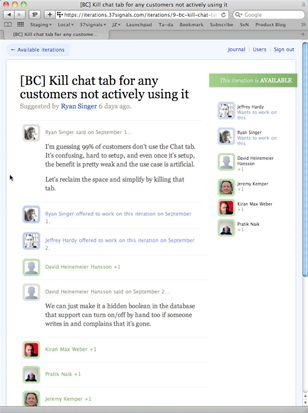
A narrow view. No need for any media queries here, the browser automatically reflows the content in our liquid layout.
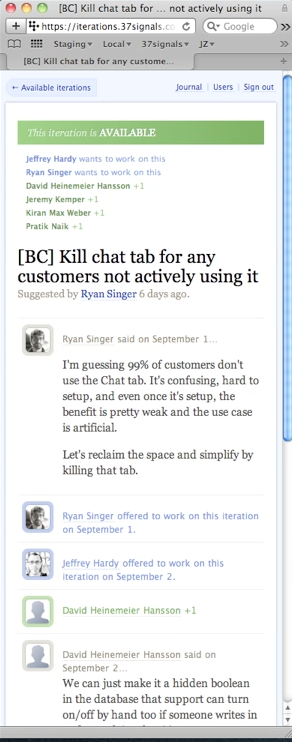
Even narrower. The margins and padding around the content collapse to maximize space, the layout changes to a single column—this is the basis of the mobile phone layout.
Backpack journal meets Adium
At 37signals, Backpack’s Journal feature answers the “Hey, what are you working on right now and what have you done lately?” question.
We wanted to make it easier to get journal entries into Backpack so we added a tiny wrapper around the existing journal API to make it work with a couple of StatusNet desktop clients (Adium is probably the most famous one). Now you can follow everyone else’s journal updates and make your own updates directly from a desktop client.
Here’s how you can use Backpack journal entries with the latest Adium.
Continued…Basecamp tips, new Extras, and plenty of case studies (Product Blog update)
Here’s a look at what’s been going on at the 37signals Product Blog lately:
Tips and Extras
Basecamphq.com/tips offers over 20 quick tips to help you be more productive in Basecamp.
Macworld talks about the latest upgrade to Outpost, Enormego’s third-party iPad/iPhone client for Basecamp.
Parachute is a third-party extra that lets you backup all your Basecamp project files to your hard drive. It will also rebuild your HTML export to include a files page and links from the original messages so you have all your project information in its original context.
Blueprint is a planning tool — conceived after trial and error creating a plan with spreadsheets — that integrates with Basecamp.
Case studies
 Case study: The author of The Typographic Desk Reference (right) talks about how he used Basecamp to edit the book.
Case study: The author of The Typographic Desk Reference (right) talks about how he used Basecamp to edit the book.
The working process with the publisher was simple. We used to-dos for edits and then messages for PDF reviews — rinse and repeat. Once we had a rhythm going, the multiple rounds of edits were done in no time. I can’t imagine orchestrating reference book collaboration without being able to pinpoint attention to the smallest details as Basecamp does. We actually started editing the TDR on Basecamp just after to-do commenting was added. This enabled us to dig deep on the details.
Case study: Red Pony is an Australian company that provides writing, editing, and training services to businesses.
As our business grew, our project management needs also became more complex, including collaborating on projects with editors, proofreaders, graphic designers and other suppliers who were working remotely. Inevitably we found that we needed a more sophisticated solution that would enable us to exchange files, maintain version control and collaborate online with clients and suppliers. After a year with Basecamp, we think we’ve found it.
Case study: The C&S Community Involvement Team uses Basecamp to organize projects for the largest food wholesaler in the USA.
Continued…It allows our team to manage tasks between our headquarters and field locations, from New Hampshire to Hawaii. We are able to maintain consistency while coordinating with many different people and departments to achieve successful results. Basecamp ensures that our small team of three people is able to operate in the most effective and efficient manner possible.
How do you keep up interest in a programming project?
The transcript from Episode #22: Programming roundtable (Part 3 of 3) of the 37signals Podcast is now available. Here’s an excerpt.
Question from SvN reader: “How do you keep up your interest in a project or product? Generally I get bored with projects after a few months.”
Jamis: Our team structure, I think, really helps that because we aren’t stuck on anything for more than about two months…Generally we work on small things, quick iterations, two or three weeks maybe for a single feature and then you move on to another product even to add something there. There’s not a lot of opportunity now for getting bored with what you’re working on.
Jeff: Even before the team structure, we sort of naturally would do things in small chunks. If you’re getting bored then you’re not doing good work, you’re not motivated. And none of us want that. So, we sort of have this built in desire to keep things small and achievable so that we can move on to something more exciting. So, I don’t really give myself much of a chance to get bored. If I find myself starting to get bored, it means that I’ve got to stop and be like: “What can I ship now and how can I go on to the next thing that feels new?”
Jeremy: I think that that feeling of being bored, there’s a little bit of self-entitlement…If you’re bored, you’re boring. You need to think about what you’re doing and find excitement in it. It takes motivation, it takes energy and you’ve got to pour it in. And if you’re not feeling it, you’re not feeling motivated, the answer probably isn’t in the product you’re working on or the code you’re working on. It’s in your approach to it, how you think about it, and how you think about your life.
